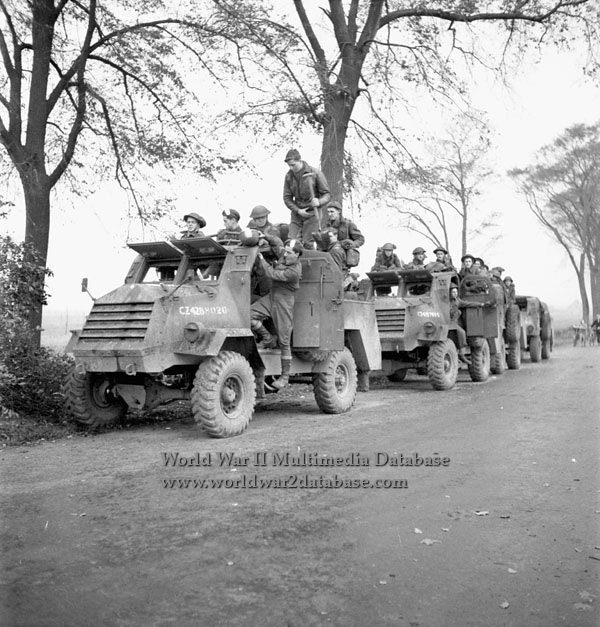| General Motors C15TA armored trucks of the Royal Hamilton Light Infantry, Fourth Canadian Infantry Brigade (Ontario), Second Canadian Infantry Division, II Canadian Corps, First Canadian Army, are stopped near Krabbendijke on the Beveland Causeway during Operation Vitality, the third phase of the Battle of the Scheldt. The C15TA was a replacement for the American M3 series scout car, and offered .55 inches (14mm) of frontal armor and .23 inches (6 mm) of side armor protection from small arms. The C15TA built on the popular Chevrolet CWT 15 light truck chassis and served with the Canadians from 1943-1945; 3,961 were built. The Second British Army took Antwerp, Belgium on September 4, 1944 almost completely intact, meaning the Allies had a suitable port for sustaining their advance into Germany. Because Antwerp lies some 60 miles (100 kilometers) inland, the port could not be used until the Scheldt was cleared of German resistance. The task of securing both sides of the Scheldt Estuary was assigned to the First Canadian Army, which had many additional units attached from British, Commonwealth, American and European Allied armies. The first two phases of the operation was to secure the town of Woensdrecht, which was accomplished with heavy casualties on October 14. The second phase, Operation Switchback, pushed Canadian and Allied units across the Leopold Canal in amphibious operations, reducing the German garrison at Breskens, Belgium, in early October. The Germans held bunkers along the Scheldt but the area was declared secure on November 3. On October 24, the Second Canadian Infantry Division opened the third phase aimed at securing South Beveland, the southern approach to Walcheren Island, the last redoubt in German hands on the Scheldt. Another amphibious operation succeeded after high casualties. The British 52nd Lowland Infantry Division opened their attack on Walcheren on October 31; the island was cleared by November 8. However, twenty-eight days of minesweeping operations were required before Antwerp could be opened to Allied shipping. The first transport to dock was the Canadian built liberty ship, Fort Cataraqui, on November 28. Recognizing the importance of Antwerp, the Germans directed half of all V2 rockets launched at the city, and made it the objective of the 1944 Ardennes operation, known in the West as the Battle of the Bulge. the C15TA served with Allied armies into the 1960s; some equipped the South Vietnamese during the Vietnam War. | |
| Image Filename | wwii0048.jpg |
| Image Size | 196.10 KB |
| Image Dimensions | 600 x 627 |
| Photographer | Bell, Ken |
| Photographer Title | Lieutenant Canadian Army Film and Photo Unit |
| Caption Author | Jason McDonald |
| Date Photographed | October 27, 1944 |
| Location | South Beveland |
| City | Krabbendijke |
| State or Province | Zeeland |
| Country | Netherlands |
| Archive | National Archives of Canada |
| Record Number | 3205115 |
| Status | Caption ©2007, ©2024 MFA Productions LLC Image in the Public Domain |

Author of the World War II Multimedia Database

